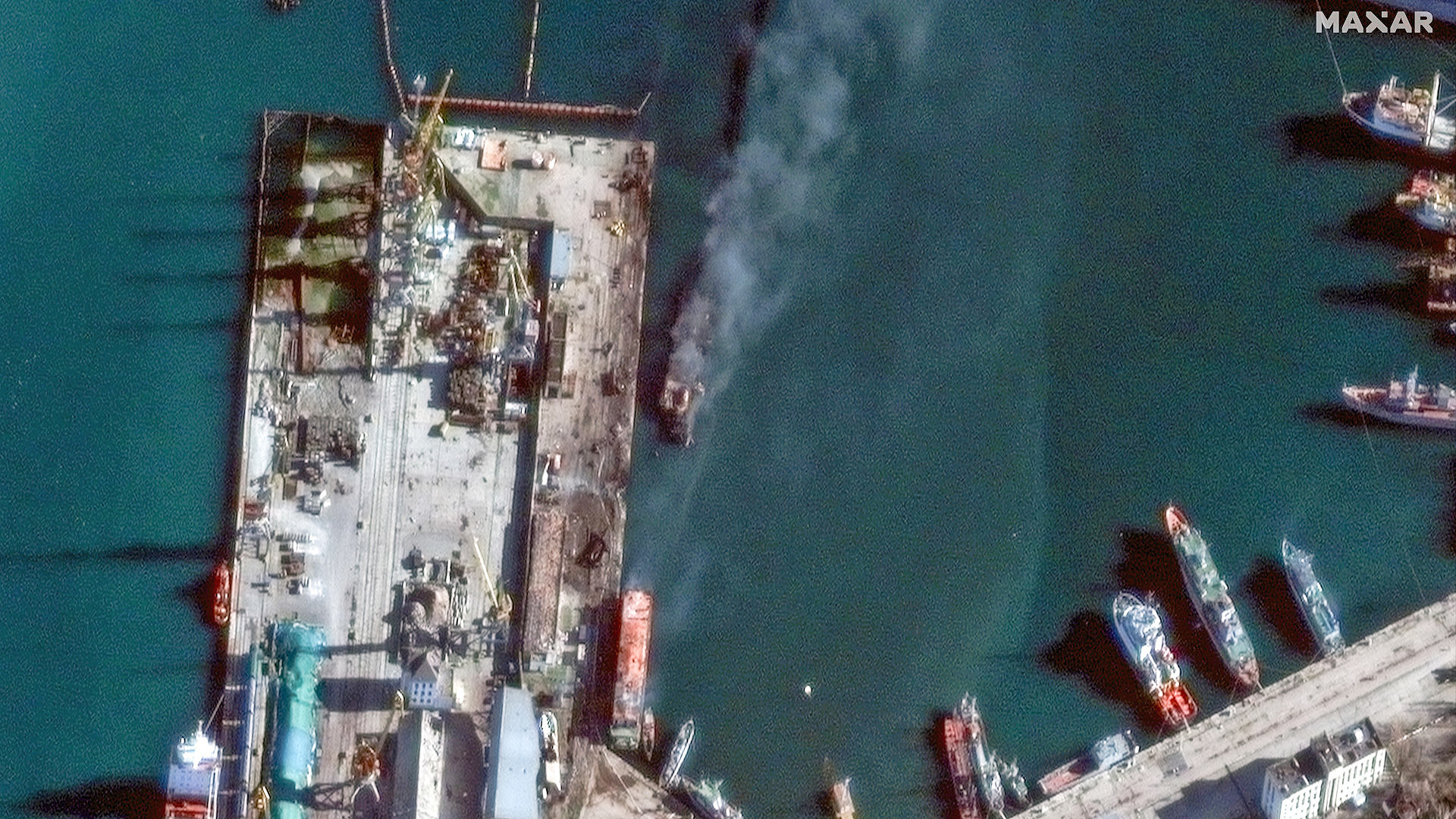New satellite imagery offers clear looks at the aftermath of the destruction of the Russian Navy’s Ropucha class landing ship Novocherkassk. There is clear damage to the pier where the vessel, which is now just a burned-out hulk, was moored in the port city of Feodosia on the Russian-occupied Crimean Peninsula. Novocherkassk suffered multiple secondary explosions, including one that produced a huge fireball, after being hit by Ukrainian air-launched cruise missiles, as you can read more about in The War Zone‘s initial reporting.
The details of the devastation can be seen in a high-resolution satellite image of Feodosia taken today that The War Zone has obtained from Planet Labs and another one from Maxar Technologies taken yesterday. The New York Times‘ Christiaan Triebert was the first to share the Maxar image.
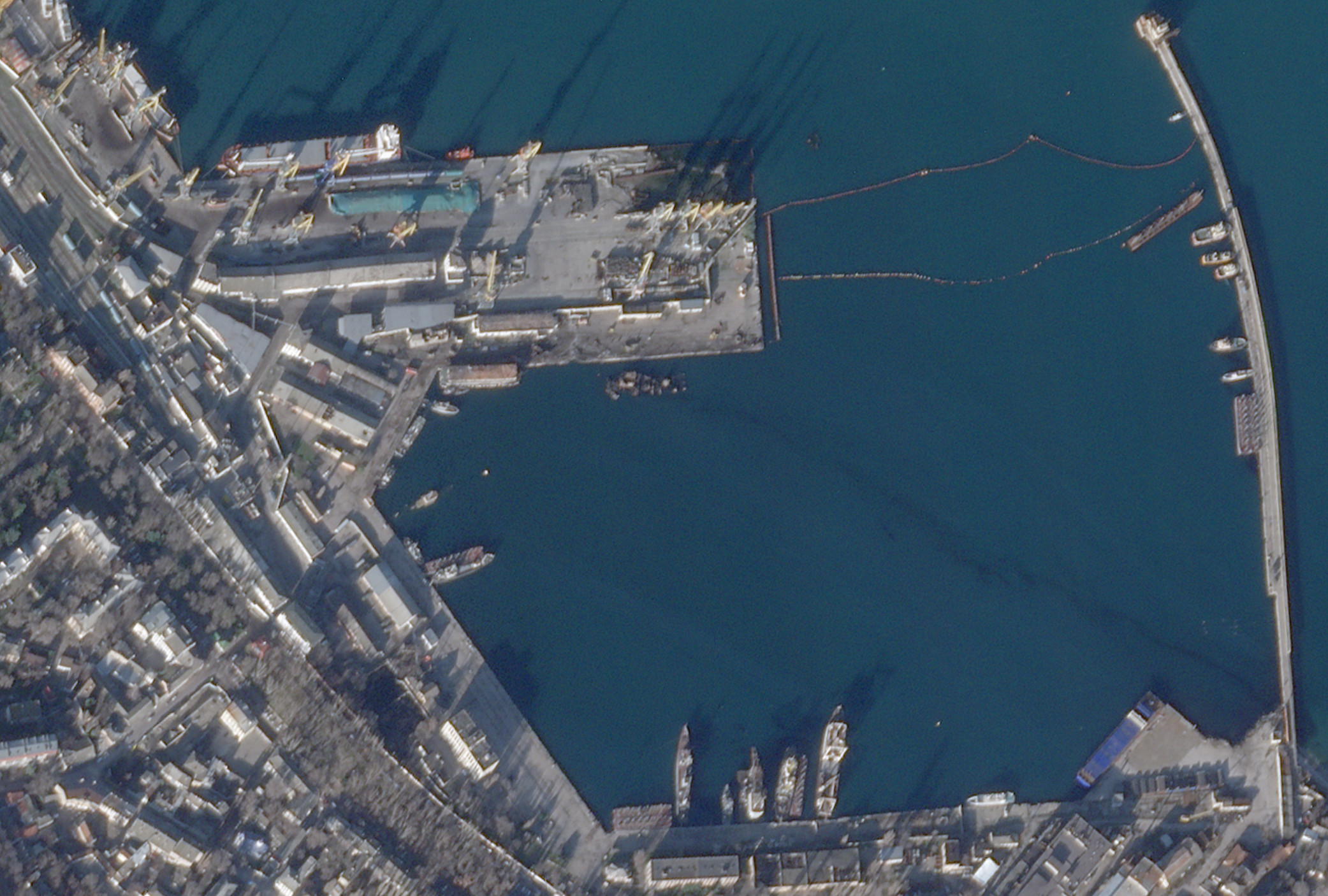

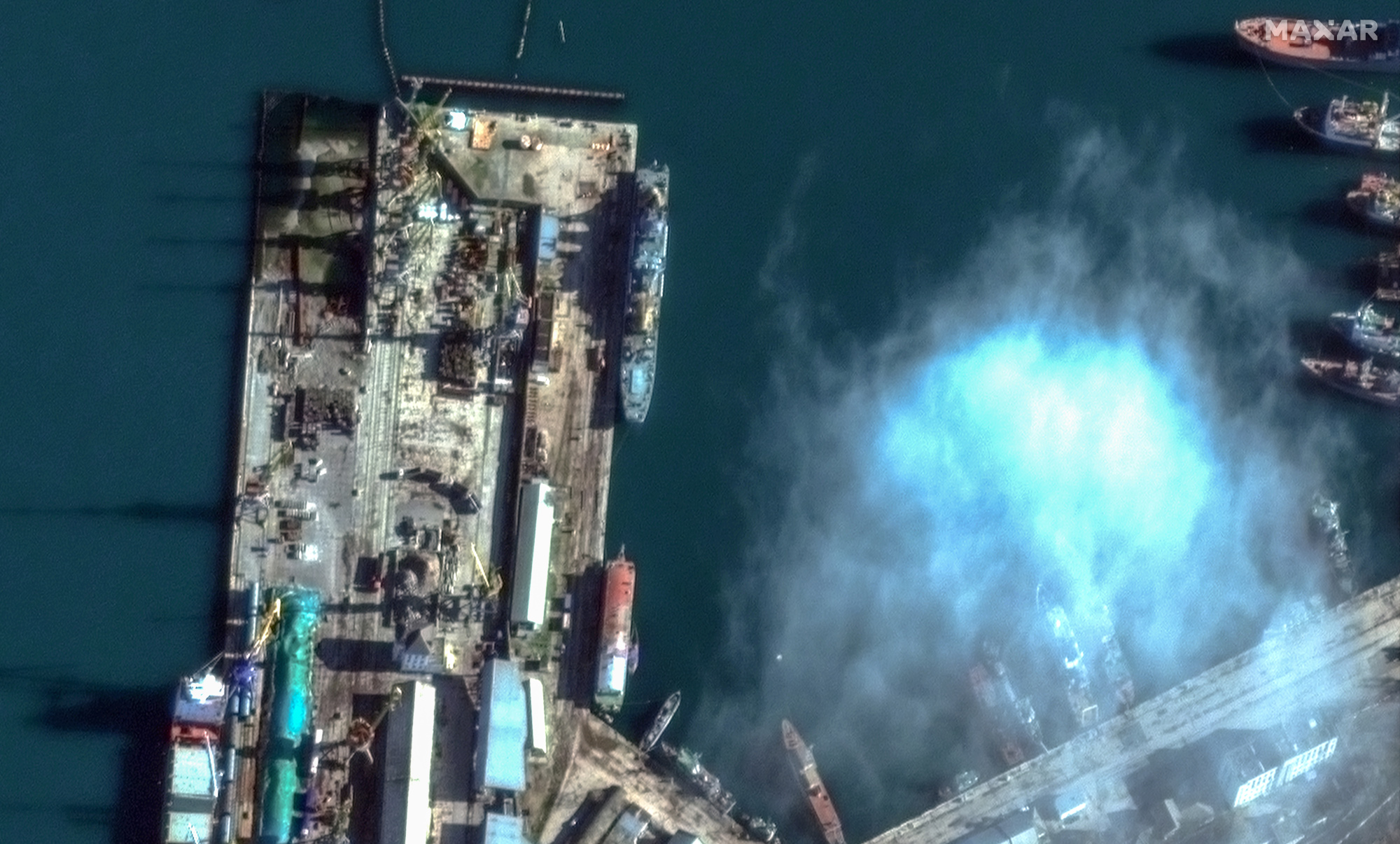
The imagery shows the submerged remains of Novocherkassk and at least one distinct impact crater and indentation in the pier alongside where the vessel had been. There are what appear to be smaller craters, as well as heavy scorching and debris, elsewhere along the pier.
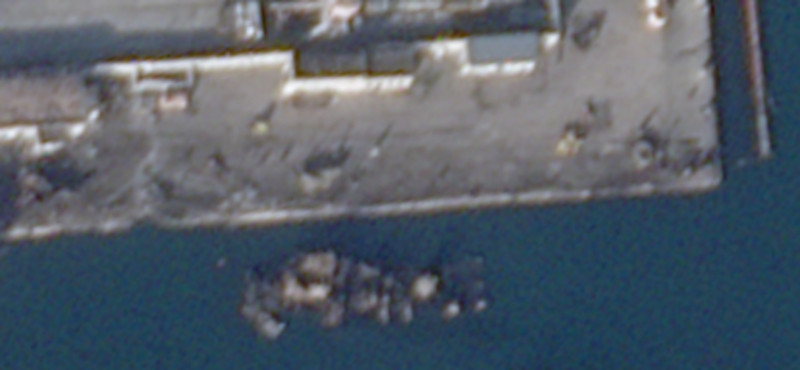
The satellite imagery shows damage to what had been a long white-roofed structure near where the landing ship had been moored. A dividing wall in the middle of the pier looks to have helped shield the opposite side to a degree, but other structures can still be seen to have been partially damaged.
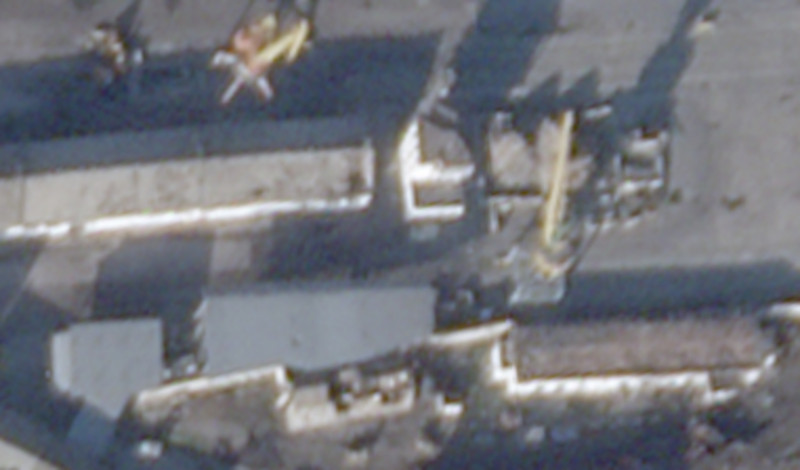
The imagery offers further confirmation that the training ship UTS-150 was left mostly submerged, if not also completely destroyed, as a result of the incident. Another large vessel or barge also looks to have been damaged. To date, the Ukrainian Air Force has only claimed to have destroyed the Novocherkassk in its strikes on Feodosia.
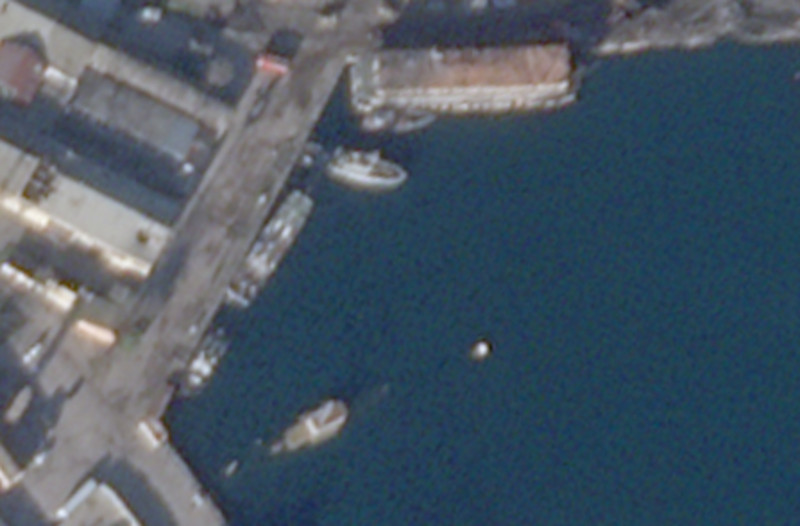
Low-resolution imagery The War Zone obtained from Planet Labs yesterday had already shown without a doubt that Novocherkassk had been completely destroyed in the Ukrainian strike and indicated that UTS-150 had been sunk.
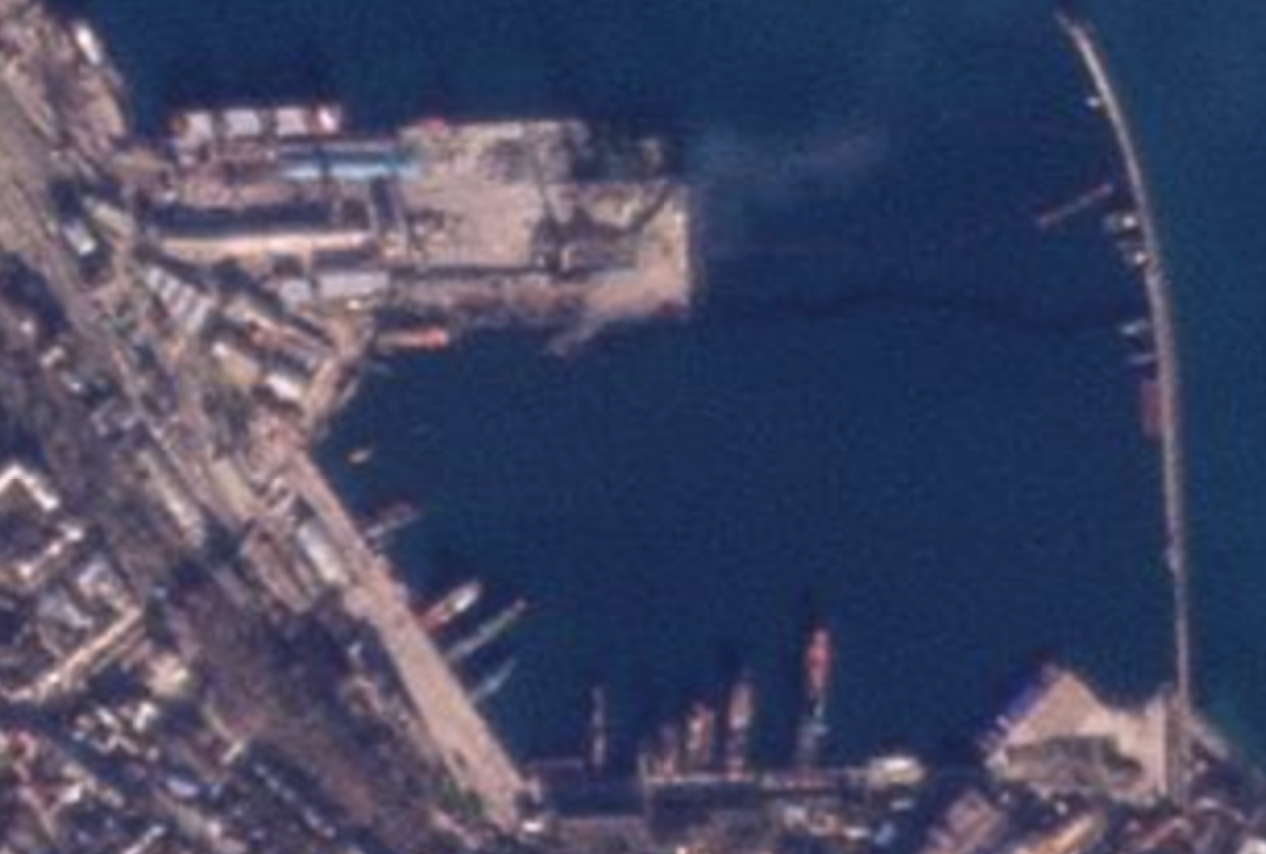
Pictures taken on the ground that first began circulating online yesterday also showed additional damage to port facilities.
Evidence had also already emerged yesterday of large debris having been sent flying a considerable distance away from the port when Novocherkassk blew up.
Russian authorities have acknowledged the incident, but have falsely claimed that the landing ship was only damaged. The Russian government has also said that only one person was killed and two more were wounded as a result of the Ukrainian strikes. Independent, but there are still unconfirmed reports saying that as many as 33 Russian Navy sailors may be missing, and are possibly dead, and that 23 more were injured.
Ukrainian authorities have also denied Russian claims that the Su-24 Fencer swing-wing combat jets that launched the missiles were shot down. There are unconfirmed reports that debris from a Storm Shadow cruise missile has been recovered in Feodosia.
Ukrainian Su-24s are the country’s platforms for launching the stealthy Storm Shadows, as well as virtually identical SCALP-EG cruise missiles, which have been supplied by the United Kingdom and France, respectively. These missiles have already been used to good effect in the past, including against Russian ships and submarines in port.
Exactly what caused Novocherkassk to explode so violently when it was hit remains unknown. The Russian Navy has been actively using Ropuchas and other large landing ships to move personnel and materiel around various occupied areas of Ukraine since the start of the all-out invasion in February 2022. In fact, one of the clearest signs that Russian forces were about to launch that operation was the redeployment of several amphibious warfare ships to the Black Sea.
Ropucha class vessels have also been notably used as ferries for military and civilian vehicles to and from Crimea following attacks on the Kerch Strait Bridge.
“They get loaded and move faster from one coast to the other. This ship could be used to transport cargo to the ports of the occupied territories,” Ukrainian Air Force spokesperson Col. Yuri Ignat told Radio Svoboda, a U.S. government-funded outlet, yesterday. “It could as well carry munitions, including the Shahed kamikaze drones, to Feodosia or other ports. The enemy launches Shaheds all the time so the destruction of a large batch, let’s hope it was the case.”
Altogether, the loss of Novocherkassk is significant for the Russian Navy, which now only has 12 of these ships still in active service in total. Another Ropucha was seriously damaged, if not totally destroyed, in a combined Ukrainian cruise missile and kamikaze drone boat attack on the Crimean port city of Sevastopol in September. Ukrainian uncrewed surface vessels seriously damaged a third one of these landing ships in a separate incident the month before.
Novocherkassk was actually caught up in a separate Ukrainian strike on the Russian-occupied port city of Berdyansk on the Sea of Azov way back in March 2022. The strike, which may have been carried out using a Tochka-U short-range ballistic missile, resulted in the destruction of the Alligator class landing ship Orsk, which also exploded in a massive fireball after being hit. Novocherkassk, as well as another Ropucha, the Tsesar Kunikov, were moored in Berdyansk near the Orsk at the time. Video footage of that incident showed one of them appearing to be on fire, at least for a time, but both of them sailing away under their own power.
The strike Novocherkassk is also yet another example of the capability that Ukrainian forces have gained through the delivery of stealthy air-launched Storm Shadow/SCALP-EG cruise missiles from the United Kingdom and France. Observers have also pointed out that the missile strike was successful in spite of a Russian surface-to-air missile site being situated relatively close to Feodosia. However, a review of satellite imagery of that location in Planet Labs raises questions about its level of operation in recent months.
At the same time, Russian air defenses have been seen struggling to intercept Storm Shadow/SCALP-EG missiles in the past. Ukrainian forces also have access to at least a small stockpile of U.S.-made ADM-160 Miniature Air Launched Decoys (MALD), and these look to have been employed to support previous Storm Shadow/SCALP-EG strikes. Ukraine may now have other decoys, which can be used to confuse or distract enemy forces, as well.
As The War Zone‘s Tyler Rogoway wrote in our previous reporting on this incident:
“Storm Shadow/SCALP-EG is an outstanding anti-ship weapon when those ships are in port/fully static. Add smaller ports where air defenses are less dense (compared to Sevastopol) and then add a target that is heavily laden with high-explosives — much bigger chance at full write off and secondary damage to infrastructure (which could have a bigger impact that destroying the ship) and other ships — and you have a perfect target.”
“Intel on what was on that ship and the window for attack was likely the main catalyst for executing it. Yes, for taking that explosive materiel off the table but more so because of the massive secondary explosion potential it had. Choosing targets with major secondary potential has been a key facet of this war on both sides, but Ukraine using its precious cruise missiles in this manner makes absolute sense and we will likely be seeing more of it going forward.”
The new satellite image of Feodosia from Maxar underscores the success of the Ukrainian strike on the Novocherkassk and only reinforces the likelihood that Ukraine’s armed forces will continue to seek opportunities to target Russian warships in port.
Contact the author: joe@thedrive.com
